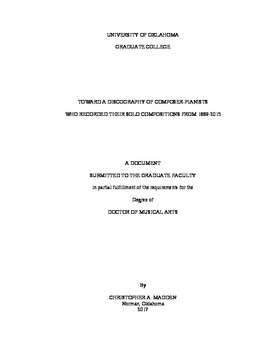| dc.description.abstract | This document presents a discography of 3,175 recordings by 214 composer-pianists who recorded their solo compositions from 1889-2015. In doing so, the discography achieves two goals. First, it clarifies information surrounding recording dates, original releases, and commercial reissues of recordings by well-known composer-pianists. Second, the discography provides a source of lesser-known solo piano music written by contemporary composers, many of whom continue to write and record their own music.
Chapter one introduces the study and explains the importance of primary recordings—the term used in this document to describe composers' recordings of their own works. In addition to providing a list of primary recordings, the discography offers a cross-section of twentieth- and twenty-first century piano music. Chapter two provides a review of literature related to discographies and describes how discographies evolved from simple recording lists to serious academic pursuits.
A discussion of historical recording technology pertaining to the piano is included in chapter three. Prior to the introduction of electrical microphones in 1925, pianists recorded via two devices: acoustic recording horns and reproducing pianos. This chapter aims to clarify questions of authenticity by describing the advantages and disadvantages of each medium. The discussion of piano rolls focuses on the "big three" reproducing piano companies: Welte-Mignon, Duo-Art, and Ampico. In addition to describing the methods used to capture artists' performances, the chapter also details each company's proprietary editing techniques.
The discography itself is presented in chapter four. Composers' last names and the compositions they recorded are organized alphabetically. When available, the discography also provides the following information for each recording: performance length, recording date, recording medium, original release information, most recent remastered CD release, and album title. The discography synthesizes information from a multitude of sources including Internet databases, bio-bibliographies, composer websites, record company catalogues, and CD liner notes. Immediately following the discography is a rollography of 650 compositions by 223 composers whose recordings for Welte-Mignon, Duo-Art, and Ampico have yet to be released in a format that is accessible to modern listeners.
Chapter five provides a summary of the research. Notable trends found throughout the discography are summarized and discussed. These trends include the presence of multiple primary recordings of the same work and the existence of both acoustic and piano roll recordings of the same composition. Chapter five also discusses the most prominent compositional styles and techniques found in the discography. Works featuring ragtime, jazz, minimalism, prepared piano, extended techniques, improvisation, and musical quotation are common throughout the discography. | en_US |
